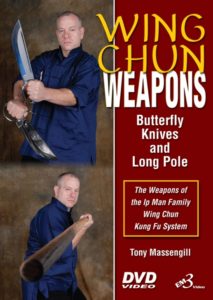What It’s About:
Master Tony Massengill presents instruction on the two Chinese weapons which are primarily associated with the Wing Chun system; these weapons are known as the Butterfly Knives and the Long Pole.
Comments:
The principle weapons associated with Wing Chun were not only a means for defense in ancient China used by the Shaolin monks, but are utilized today to provide further development in one’s skill in the techniques of the Wing Chun Kung fu system. Instruction in this DVD begins with the Long Pole or what is known as the 6.5 point pole or staff, which refers to seven movements in the application of the pole. The seven movements are linked with six attack and defense techniques and one movement associated with attack only. Master Massengill provides the learner with the reasoning behind the correct position of the hands in holding the pole and the basic sequence used for development, but also warns the practitioner in its improper use or training which could lead to severe injury of the joints.
 The actual movements of the pole form do not look all that impressive, but their benefit in ones training soundly contributes to one’s stance development and projection of power. One can easily experience in the practice of the pole form and through its applications how centerline theory applies to the Wing Chun system of martial art techniques.
The actual movements of the pole form do not look all that impressive, but their benefit in ones training soundly contributes to one’s stance development and projection of power. One can easily experience in the practice of the pole form and through its applications how centerline theory applies to the Wing Chun system of martial art techniques.
Perhaps, the weapon that is best known and is attributed to the Wing Chun system are the Butterfly Knifes. They are unique in terms of their design, but also in the performance of the form which incorporates all the movements of Wing Chun’s three forms which are Siu LimTao, Chum Kiu and Bil Jee.
The Butterfly Knife form has eight angles of attack, while utilizing the basic stance of Siu Lim Tao, the rotating postures of Chum Kiu and the stepping pattern associated with Bil Jee. Practicing the Butterfly Knife form will definitely improve as well as reinforce your technique and skill in applying Wing Chun. If you want to learn the basics associated with these two weapons, then this DVD will provide you with the theory, basic exercises and applications of each weapon’s use. The series of DVDs produced by EM3 Video of Master Tony Massengill are excellent instructional media in sound and video quality. The purchase of these DVD’s would enhance any ones collection and would be a wise investment for instructional material of the Wing Chun system.
Technical Specifications:
Title: Tony Massengill – Wing Chun Weapons
DVD Length: 39 mins
Region: 0
Type: DVD-R
Format: NTSC
Video Quality: Above Average
Audio Quality: 5/5 (Professional)
Content Overview:
- Introduction
- The Wing Chun Pole
- Basic attributes of the pole
- Reference to its 6.5 points or seven movements.
- Six points of attack and defense.
- One point referring to attack only.
- Reference to its 6.5 points or seven movements.
- The basis or purpose of pole training.
- The centerline and range of coverage.
- Steadiness and balance.
- Focus and applying force.
- Power training exercises
- Basic thrusting movement-standing posture.
- Downward thrust movement.
- Forward Thrust movement.
- Using the pole as a unit.
- The sequence of the thrust.
- The pole becomes the centerline.
- The purpose of the pole.
- It’s for fighting not for show.
- Provides development for the arms and wrist.
- The thrusting pole exercise from centerline and heart line position.
- The shoulder becomes the centerline.
- The lower postures of the thrusting form.
- Techniques of the pole form.
- Using the short pole for training.
- Starting position to cover the centerline.
- The drop and thrust position.
- Turning at the proper angle in the form.
- Stepping forward and moving back in the form.
- The relationship between the pole and the hands.
- The Butterfly Knives
- How the knife form is related to the hands.
- The eight angles of attack.
- In holding the knifes, one’s hands become the elbows.
- The points of vulnerability for attack are different from the open or empty hand applications.
- Become aware of the opponents vulnerable parts.
- the arms, biceps, and the waist.
- The Butterfly Knife form
- There are eight sections of the form.
- the eight sections are individual forms and can be performed separately.
- There are three basic movements.
- Stepping.
- The shifting horse.
- Thrusting action.
- Butterfly knife form attributes.
- Static sections of the form.
- Active sections of the form.
- How the knife form is related to the hands.
Reviewed by: George Hernandez
Date: May 14, 2011
DVD Bought on: Everything Wing Chun
